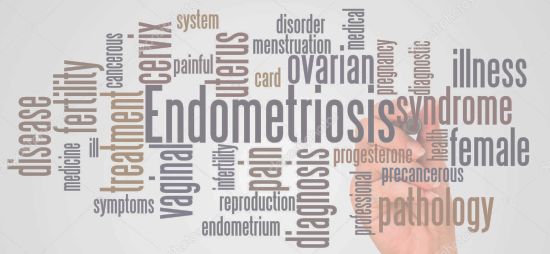A closer look at possible causes of endometriosis
It seems to be almost impossible to know what really causes endometriosis and there are many theories and much speculation surrounding this disease. No two women are the same and the reason they develop the disease could have very different explanations.

Possible theories and causes of endometriosis
Here is a look at some of the possible causes of endometriosis with some interesting theories and findings.
The retrograde menstruation theory
This is the movement of menstrual flow, including sloughed endometrial tissue, back through the fallopian tubes into the peritoneal cavity during menstruation. Retrograde menstruation has been documented in a variety of surgical studies, and it is estimated to occur in 90% of all menstruating women. So, if retrograde menstrual blood is being blamed as the cause of endometriosis, then most women on the planet should have it.
For most women, menstrual tissue debris that enters the peritoneal cavity is destroyed before the tissue can implant in the peritoneal cavity. It is destroyed by the immune system. If retrograde menstruation is so common, with almost all women experiencing it to some degree with each cycle, why do only 10% to 15% of women develop endometriosis?
The other problem with the theory of retrograde menstruation is that endometriosis has been found in other parts of the body, including the lungs, brain, limbs and even the eyes. This theory also does not account for the cases of endometriosis found in men who have been taking estrogen as part of treatment for prostate cancer.
Immune system response
In women without endometriosis, ectopic implants of endometrial tissue are destroyed by a variety of immune and inflammatory reactions. These include activation of the cell-mediated immune system, including an increase in the production and activation of cytotoxic T cells that respond to foreign invaders, and the stimulation of natural killer cells.
Inflammatory response
The damage, infertility and pain produced by endometriosis may be due to an over-active response by the immune system to the early presence of endometrial implants. The body, perceiving the implants as hostile, launches an attack.
Levels of large white blood cells (called macrophages) are elevated in endometriosis. Macrophages produce very potent factors, which include cytokines (particularly those known as interlukins) and prostaglandins. Such factors are known to produce inflammation and damage in tissues and cells.
Growth factors
Vascular endothelial growth factor (VEGF) is secreted by endometrial cells. Under normal circumstances, VEGF is secreted within the uterus. When oxygen levels drop following menstruation and blood loss, VEGF levels rise and promote the growth of new blood vessels. This process is important for repairing the uterus following menstruation.
When endometrial cells land outside the uterus, however, investigators theorise that this same process occurs with unfortunate results. The cells secrete VEGF when they are deprived of blood and oxygen, which in turn stimulates blood vessel growth. In this case, however, blood vessel growth serves to promote implantation outside the womb.
Iatrogenic Transplantation Theory
Which is the belief that accidental transference of endometrial tissue from one site to another occurs during abdominal surgery. This is highly uncommon today due to advanced surgical management. It does not account for the disease being present in the first place, and does not account for the occurrence of endometriosis in other parts of the body.
Liver Disorder
Some people believe that liver disorders are the key in predisposing a woman to the disease. The liver is a filter of sorts. It detoxifies our body, protecting us from the harmful effects of chemicals, elements in food, environmental toxins, and even natural products of our metabolism. The liver also regulates and removes estrogen from the body through a series of processes.
Anything that impairs liver function or ties up the detoxifying function will result in excess estrogen levels. This can happen whether it has a physical basis as in liver disease, or an external cause as with exposure to environmental toxins, drugs, of dietary substances. Estrogen is produced not only internally but also produced in reaction to chemicals and other substances in our food. When it is not broken down adequately, higher levels of estrogen build up.
If for whatever reason, the liver begins failing to remove the estrogen, symptoms such as chronic fatigue and allergies (common in endometriosis) can appear. Another interesting issue is that studies have also shown that the liver is the major target for dioxin and is severely affected by the chemical. A significant number of people exposed to dioxin have been found to have enlarged liver and impairment of liver function.
Hereditary
Preliminary study results indicate that patients with relatives who have endometriosis may be genetically predisposed to develop it themselves. This theory was suggested as early as 1943. There is research currently underway on this theory. There will however be many women who are the only ones in their family to develop this disease.
Thyroid Link
Some researchers believe that some women with endometriosis may be suffering from thyroid dysfunction. In one survey of the thyroid function and endocrine levels (hormones secreted from the glands of the pituitary) of 120 women with endometriosis, it was found that although their routine thyroid tests were normal, the incidence of thyroid auto-antibodies was 20% higher than the reported percentage in other women.
In some cases, the levels of thyroid auto-antibodies were consistent with a definite thyroid auto-immune disease. Some of these women were treated with low-dose thyroxin and the women’s health improved considerable.
History of Abuse
There appears to be a high incidence of a history of sexual abuse in women who later develop endometriosis. Statistics that have come from a survey by the Endometriosis Research Centre show that approximately 42% of women who responded to the survey with endometriosis suffered from sexual abuse before they developed endometriosis.
More theories to the cause of endometriosis can be found HERE
Reference:
https://www.endometriosis-uk.org/causes-endometriosis
https://www.mayoclinic.org/diseases-conditions/endometriosis/symptoms-causes/syc-20354656
https://en.wikipedia.org/wiki/Endometriosis
 As featured in:
As featured in:




